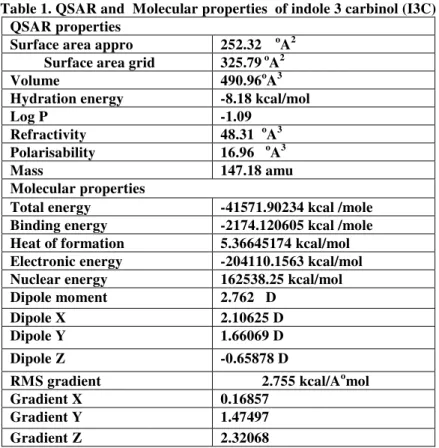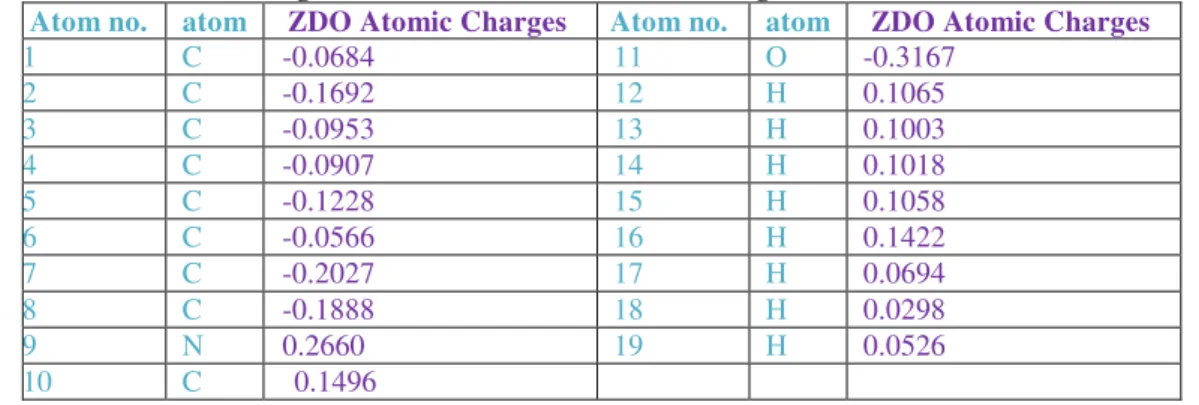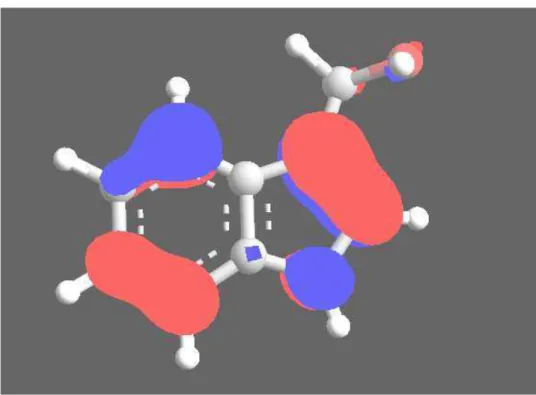A Hypothetical Study on Structural aspects of Indole-3-carbinol
(I3C) by Hyperchem and Arguslab 4 software
K. Laxmi
Department of Chemistry, Chaitanya Bharathi Institute of Technology (CBIT), Gandipet, Hyderabad -500 075, INDIA
ABSTRACT
Indole-3-carbinol (I3C) is a plant compound derived from glucosinolates, found in cruciferous vegetables. Researchers have indicated that I3C shows great promise as a cancer preventative and hormone-balancing agent. HyperChem 7.5 software was used for quantum mechanical calculations. The geometry optimization was carried out using Ab Initio method. QSAR parameters were generated with semi empirical single point AM1 method. The HOMO and LUMO frontier orbital energies were also computed. Conformational analysis and geometry optimization of Indole-3-carbinol (I3C) was performed according to the Hartree-Fock (HF) calculation method by ArgusLab 4.0.1 software .The minimum heat of formation is calculated by geometry convergence function by ArgusLab software. PM3 semi empirical quantum mechanical calculations were carried out on structure of Indole-3-carbinol (I3C) to obtain the geometries, geometric parameters and thermodynamic parameters. The HOMO and LUMO frontier orbital energies were also computed for the optimized molecule. Electron density surface of IDOX is determined using PM3 geometry with PM3 wavefunciton.
Keywords
: I3C, Hyperchem 7.5 Software, QSAR, Argus Lab 4.0.1, conformational analysis, geometry optimization, HOMO, LUMOI.
INTRODUCTION
M.P.of Indole-3-carbinol (I3C) 96-99 °C (lit.) and storage temperature is 2-8°C.
Fig.1 structure of Indole-3-carbinol (I3C)
Between 1990 and the current time, there have been over 120 peer-reviewed scientific studies on indole 3 carbinol with cancers such as breast cancer, prostate cancer, cervical cancer and even respiratory tract cancers. For example, in one (albeit small) double blind study on women with cervical cancer, supplementation of 200 mgs to 400 mgs of I3C reversed the early stages of cancer in 8 of the 17 women. I3C is potent stuff.
Anti-cancer activity:
I3C has been shown in research to inhibit the action of some aflatoxins, which are carcinogenic. It also prevents aflatoxin-induced liver cancer, leukaemia and colon cancer.
I3C can reduce, and even reverse, breast tumour growth
In cell cultures, I3C inhibits human papilloma virus (HPV) proliferation, and the development of cysts and pre-cancerous lesions. There is some evidence that I3C may help prevent recurrences of respiratory papillomatosis. Further research indicates that I3C may well protect your liver, but the most interesting aspect of I3C is its seeming ability to reduce, even reverse, oestrogen-driven tumour growth. The Roman was right!
I3C seems to act in five ways:
• By converting highly active oestrogen forms, and their by-products, to much safer compounds.
• By partially blocking oestrogen receptor sites on cell membranes.
• By returning alpha and beta receptor site expression to normal levels
• By blocking other cancer-enhancing receptor sites
• By directly killing cancer cells.
I3C gives rise to a broad spectrum of beneficial compounds upon its consumption and digestion. Various researchers and reputable organizations, such as the National Cancer Institute and the Strang Cancer Prevention Center, have interest in I3C as a natural cancer prevention agent, particularly for breast, cervical, endometrial, and colorectal cancer. Several prospective clinical studies have shown that populations that consume higher amounts of cruciferous vegetables have lower incidence of cancer, or improved biochemical indices (e.g.,
decreased oxidative stress), compared to controls. 1-19
In fact, epidemiological studies provide evidence that the consumption of cruciferous vegetables protects against cancer more effectively than the total intake of fruits and vegetables.20,21
Theoretical studies
The molecule Indole-3-carbinol (I3C) was built by Hyperchem tools22-27 then the geometry optimization was carried out by employing Ab Initio optimized semi empirical single point AM1 method. The minimum potential energy was calculated for I3C through the geometry convergence map. Mulliken Atomic Charges , ZDO Atomic Charges of I3C and Ground State Dipole (debye) of were determined using PM3 method. Computational advances have generated many tools which are widely used to construct models, minimization and representations of molecular structure.
All conformational analysis (geometry optimization) study was performed on a window based computer using Argus lab software28-34. The I3C structure is generated by Argus lab, and minimization was performed with the semi-empirical Parametric Method 3 (PM3) parameterization.35,36
The minimum potential energy is calculated by using geometry convergence function in Argus lab software. Surfaces created to visualize ground state
properties as well as excited state properties such as orbital, electron densities, electrostatic potentials (ESP) spin densities and generated the grid data used to make molecular orbital surfaces to visualize the molecular orbital and making an electro static potential mapped on electron density surface.
II.
RESULTS AND DISCUSSIONS
Hypothetical study of Indole-3-carbinol (I3C) by HyperChem 7.5 software The Hyper Chem 7.5 software was used for quantum mechanical calculations to generate spectral data. After building molecule by Hyperchem tools, the geometry optimization was done using Ab Initio method ( Figs.1 to 3). The spectral data is generated with single point AM1 method approximation, for indole 3 carbinol(I3C). The calculations are sensitive to the values of input parameters such as molecular geometry, bond lengths and values of coulombic, resonance and overlap integrals ball and cylinders model tubes model From Potentiometric titrations it has been observed that there is only one dissociable proton present in the ligand I3C. This is attributable to dissociation of proton from the ligand.
Prospective view and active conformation of indole 3 carbinol(I3C) are shown in Figs. 2&3
Fig.2 Prospective view of indole 3 carbinol(I3C)
Table 1. QSAR and Molecular properties of indole 3 carbinol (I3C) QSAR properties
Surface area appro 252.32 oA2 Surface area grid 325.79 oA2
Volume 490.96oA3
Hydration energy -8.18 kcal/mol
Log P -1.09
Refractivity 48.31 oA3
Polarisability 16.96 oA3
Mass 147.18 amu
Molecular properties
Total energy -41571.90234 kcal /mole
Binding energy -2174.120605 kcal /mole
Heat of formation 5.36645174 kcal/mol Electronic energy -204110.1563 kcal/mol
Nuclear energy 162538.25 kcal/mol
Dipole moment 2.762 D
Dipole X 2.10625 D
Dipole Y 1.66069 D
Dipole Z -0.65878 D
RMS gradient 2.755 kcal/Aomol
Gradient X 0.16857
Gradient Y 1.47497
Gradient Z 2.32068
Quantitative structure activity relationship studies (QSAR studies)
QSAR properties like surface area, volume, hydration energy, log P, refractivity, polarisability, mass, total energy etc. of I3C were determined by single point AM1 method. (Table .1) QSAR properties allows calculation and estimation of a variety of molecular descriptors commonly used in quantitative structure activity relationship (QSAR) studies7,8.
This analysis represents an attempt to relate structural descriptors of compounds with their physicochemical properties and biological activities.
According to the AM1 calculation binding energy of I3C is about -2174.120605 kcal /mole. The heat of formation of I3C is about 5.36645174 kcal/mol and it is endothermic. Dipole moment of indole 3 carbinol (I3C) is 2.762D
The trends of the molecular properties (Table.1) obtained by calculations are in good agreement with the experimental results7-12.
This analysis represents an attempt to relate structural descriptors of compounds with their physicochemical properties and biological activities.
Quantum Chemical Studies of indole 3 carbinol (I3C)
The frontier molecular orbital energies (i.e., EHOMO and ELUMO) 9,10 are significant parameters for the prediction of the reactivity of a chemical species. The EHOMO is often associated with the electron donating ability of a molecule. The ELUMO indicates the ability of the molecule to accept electrons. Therefore higher value of EHOMO indicates higher tendency for the donation of electron(s) to the appropriate acceptor molecule with low energy and empty molecular orbital.
HOMO of I3C E= -8.209828 eV LUMO of I3C E= 0.3334137 eV
Fig.4 Highest occupied molecular orbital (HOMO) and Lowest unoccupied molecular orbital (LUMO) of Indole-3-carbinol (I3C)
Hypothetical study of Indole-3-carbinol (I3C) by Argus lab software
The molecule indole 3 carbinol(I3C) is build using molecule builder of Argus lab28-35. The "Molecule Settings of I3C are Atoms20, Net charge 0 and Valence electrons 56
Table 2: Atomic coordinates of Indole-3-carbinol (I3C) - Input Atomic Information Input Atomic Information
The atomic input information for above calculation is given in Table no.2. The final geometrical energy and SCF energy was found to be -61.0179909654 au/-38289.4020 kcal/mol as calculated by RHF/ PM3method, as performed by ArgusLab 4.0.1 suite.(Table no.3)
Table 3: Calculating SCF using one electron matrix---Performing SCF Cycle Energy (au) Difference Cycle Energy (au) Difference
1 -30.350762 21 -61.017990937 -2.80369e-008
2 -41.774967396 -11.4242 22 -61.017990952 -1.48481e-008
3 -43.905230305 -2.13026 23 -61.017990958 -6.55427e-009
4 -49.865539442 -5.96031 24 -61.017990962 -3.64935e-009
5 -52.732016517 -2.86648 25 -61.017990964 -1.76834e-009
6 -54.515449090 -1.78343 26 -61.017990964 -8.81982e-010
7 -57.849009142 -3.33356 27 -61.017990965 -4.42924e-010
8 -60.490932094 -2.64192 28 -61.017990965 -2.21917e-010
9 -60.964263769 -0.473332 29 -61.017990965 -1.13175e-010
SCF converged
Final SCF Energy = -61.0179909654 au Final SCF Energy = -38289.4020 kcal/mol Final Geometrical Energy = -61.0179909654 au Final Geometrical Energy = -38289.4020 kcal/mol
Table 4 : List of Mulliken Atomic Charges and ZDO Atomic Charges of Indole-3-carbinol (I3C) using ArgusLab software ZDO Atomic Charges of I 3 CAR
Atom no. atom ZDO Atomic Charges Atom no. atom ZDO Atomic Charges
1 C -0.0684 11 O -0.3167
2 C -0.1692 12 H 0.1065
3 C -0.0953 13 H 0.1003
4 C -0.0907 14 H 0.1018
5 C -0.1228 15 H 0.1058
6 C -0.0566 16 H 0.1422
7 C -0.2027 17 H 0.0694
8 C -0.1888 18 H 0.0298
9 N 0.2660 19 H 0.0526
10 C 0.1496
ZDO Atomic Charges) of Indole-3-carbinol (I3C) were given in Table. 4
Heat of Formation: The atomic heat of formation is the heat that released during the formation of the stable form of the element from individual atoms at standard conditions. It should be noted that thermodynamical corrections (e.g., zero-point energies) should not be added to the formation energy, as these are implicitly included by the parametrization. The most energetically favorable conformation of I3C is found to have a heat of formation of -6.6437 kcal/mol via use of the Argus Lab software.
HOMO and LUMO orbitals of I3C
The HOMO and LUMO orbitals are commonly known as Frontier Orbitals and were found to be extremely useful in explaining chemical reactivity. Electrophilic attacks were shown to correlate very well with atomic sites having high density of the HOMO orbital, whereas nucleophilic attacks correlated very well with atomic sites having high density of the LUMO orbital (Kunichi Fukui was
awarded the Nobel prize in chemistry in 1981 for developing this concept). HOMO (Highest Occupied Molecular Orbital i.e MO 28) and LUMO (Lowest Unoccupied Molecular Orbital i.e MO 29) of I3C are shown in fig 5 and fig.6 respectively. This was done theoretically using PM3.
Electronic properties: It is important to examine the E HOMO and E LUMO so as to explain the electronic properties of the complex. This was done theoretically using PM3. The positive and negative phases of the orbital are represented by the two colors, the blue regions represent an increase in electron density and the red regions a decrease in electron density.
Fig.5 I3C HOMO--Visualize the HOMO (Highest Occupied Molecular Orbitals) (MO 28) of I3C, blue shows positive and red shows negative.
Fig.7 The complete surface with the color map of ESP of I3C---ESP MAPPED DENSITY
III.
CONCLUSION
Hyperchem study on Indole-3-carbinol (I3C) compound is informative in understanding various physicochemical aspects of compounds. The HOMO and LUMO frontier orbital energies computed for the optimized molecule of Indole-3-carbinol (I3C) indicated that the above compound possess potential electron donor atoms.
The most energetically favorable conformation of conformation of I3C is found to have a heat of formation of -6.6437 kcal/mol via use of the Argus Lab software. The present work indicates that the best conformation of I3C is found to be at -61.0179909654 au /-38289.4020 kcal/mol which is the minimum potential energy by using Argus Lab software. At this point I3C will be more active as anti cancerous agent.
Mulliken Atomic Charges and ZDO Atomic Charges and thermodynamic parameters were calculated and the data obtained from the calculated parameter are analysed and is found to be well within the accuracy of computational results.
In conclusion, these studies does not only presented us the opportunity to take a critical look at this novel compound but has also given us the opportunity to compile fundamental result on properties that cannot be calculated in the laboratory.
References
[1.] Cover CM et al.Cancer Res. 1999; 59 1244-51
[2.] McDonnell R., Food Chain Toxicol 1998; 26.59-70.
[3.] Rosen et al Otolaryngol Head Neck Surgery 1998. 118:810-815.
[4.] Shertzer et al. Biochem Pharmacol 1988; 37. 333-8
[5.] Bradlow, Ann. N Y Acad Science 1999; 889. 204-13
[6.] Bell et al, Gynecol oncol 2000; 78. 123-9 [7.] Wong GYC, Bradlow HL, Sepkovic DW, et
al. J Cell Biol. 1988; 28:111-116 0.0500 to 0.0409 -0.0045 to -0.0136
0.0409 to 0.0318 -0.0136 to -
0.0227
0.0318 to 0.0227 -0.0227 to -
0.0318
0.0227 to 0.0136 -0.0318 to -0.0409
0.0136 to 0.0045 -0.0409 to
[8.] Bradlow HL, Michnovicz JJ, Wong GYC, et al. Cancer Epidemiol Biomarkers Prev. 1994; 3 :591-595.
[9.] Bradlow HL, Sepkovic DW, Telang NT, Osborne MP. Ann NY Acad Sci. 1999; 889:204-213.
[10.] Custodio JB, et al. 1994. Biochem Phearmacol 47:1989-98.
[11.] Devanaboyina U, et al. 1997. Proc Annu Meet am Assoc. Cancer Res 38:A2427. Grubbs CJ, et al. 1995. Clin Cancer Res 2:1439-44.
[12.] He Y-H, Freisen MD, Ruch RJ, Schut HAJ. Food Chem Toxicol. 2000; 38:15-23. [13.] Michnovicz JJ, Bradlow HL. J Natl Cancer
Inst. 1990; 50:947-950.
[14.] Niwa T, Swaneck G, Bradlow HL. Steroids. 1994; 59:523-527.
[15.] Shertzer HG, et al. 1988. Biochem Pharmacol 37:333-38.
[16.] Telang NT, et al. 1997. Proc Soc Exp Biol Med 216:246-52.
[17.] Thangaraju M, et al. 1994. Cancer 74:78-82. [18.] Verhagen H, et al. 1995. Cancer Res
38:1410-13.
[19.] Yang JH, et al. 1999. Carcinogenesis 20:13-18.
[20.] Terry P, Wolk A, Persson I, Magnusson C. Brassica vegetables and breast cancer risk. J Am Med Assoc 2001; 285: 2975–77. [21.] Keck AS, Finley JW. Cruciferous
vegetables: cancer protective mechanisms of glucosinolate hydrolysis products and selenium. Integr Cancer Ther 2004;3(1):5-12.
[22.] A.Broo, Per Lincoln, Ab- initio and Semi empirical Calculations of Geometry and Electronic Spectra of Ru complexes and Modeling DNA Binding, Inorg. Chem., 1997, 36, 2544- 2553.
[23.] RK.Gilpin , Predicting ID NMR Spectra – HyperNMR, Analytical Chemistry.,1995, 67, Iss 17, A 541.
[24.] O.vanciuc, Hyperchem Release 4.5 for Windows, Journal of Chemical Information and Computer Sciences.,1996., 36 , Iss 3 , 612-614.
[25.] WR.Winchester and MP-Doyle, Hyperchem,
USA., 2006, 12 (b) HyperChem® Computational Chemistry, Part 1 &Part 2 Hypercube, Inc. Publication ,HC50-00-03-00,1996,21-67
[28.] Peng C, Ayali PY, Schlegel HB and Frisch MJ, (1995) J. Comp Chem., 16: 49-51. [29.] Cramer CJ and Truhlar DG(1992),
Computer-Aided Mol. Design, 6: 629-666. [30.] Merz JKM and Kollaman PA (1989), . J.
Am. Chem. Soc., 11(1): 5649-5658.
[31.] Still WC, Tempczk A, Hawley RC and Hendrickson T(1990) . J. Am. Chem. Soc.,112: 6127- 6129.
[32.] Martin YC (1998). Perspective in drug discovery and design. Springer Publisher, USA, 12th Volume, pp.3- 23.
[33.] Cruciani G, Clementi S and Pastor M (1998). GOLPEguided region selection. Perspectives in Drug Discovery and Design, 12-14(16): 71-86.
[34.] Dunn III and Hopfinger AJ (1998). Drug Discovery, Kluwer Academic Publishers. Chapter 12, pp.167-182.
[35.] Dewar MJS, Zoobisch EG, Healy EF and Stewart JJP(1985). ). AM1: A new general purpose quantum mechanical molecular model. J. Am. Chem. Soc. 107: 3902-3910. [36.] James J. P. Stewart, J. Comp. Chem., 10,



